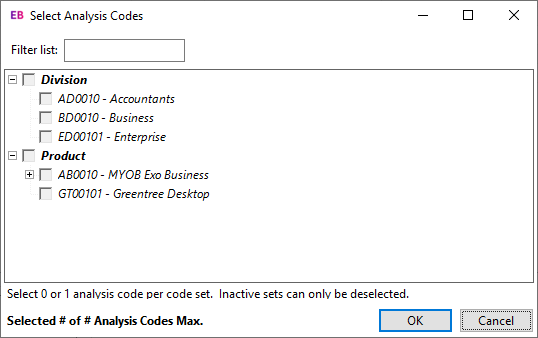Analysis Codes
Analysis Codes are arbitrary codes that you can assign to transactions. They are a customisable way of grouping related transactions together for sorting and reporting. This enables you to collect and monitor income and expenditure for a particular function or event that is not captured by a project code or class.
You can assign analysis codes to line items in all transaction types. A transaction can have more than one code assigned to it.

Setting up Analysis Codes
Set up Analysis Codes in Exo Business Configurator. Codes are grouped into CodeSets. Before you can create Analysis Codes, you must set up at least one CodeSet.
Note: You can create up to five CodeSets.
To set up a CodeSet:
-
Open Exo Business Configurator and go to the Essential > Analysis Codes section.
-
Click the New CodeSet button.
-
Enter a name and description for the set.
-
To have the codes in the set follow a specific pattern, enter a code template in the Analysis Code Validation field.
A code template is a string consisting of the letters A and N, where A represents an alphabetical character and N represents a numeric character. For example, entering the template AANNN means that all codes in the set must consist of two alphabetical characters followed by three numbers. If you do not enter a template, codes can contain any characters.
-
Click Save.
Activate a CodeSet by selecting its Active box. A CodeSet must have at least one code in it before you can activate it.
Adding Analysis Codes
To add an Analysis Code:
-
Select the Code or CodeSet to create the code under and click New Code.
-
Enter the code. If a template has been defined for the code's CodeSet, the code that you enter must match the format of the template. The code is highlighted red if it does not match the template.
-
Enter a name and description for the code.
-
Click Save.
You can assign default Analysis Codes to users under Configuration Assistant > Staff > Users. These codes are assigned by default to any transaction that the user enters.
Analysis Code Profile Settings
You might need to configure these Company-level profile settings:
-
Default analysis codes required - specifies whether or not default Analysis Codes must be specified for each user under Staff > Users.
-
Analysis codes mandatory for every transaction - specify whether or not users must select one or more Analysis Codes for every transaction they enter.
-
Maximum number of analysis codes per transactions - enter the maximum number of Analysis Codes that you can apply to a single transaction.
-
Hide Analysis Codes Column - if you do not intend to use Analysis Codes, this setting can be used to hide the Analysis Codes column on the Sales Order, Purchase Order, Creditors Invoice, Debtors Invoice, Stock Movement, Cashbook and Journal entry windows.
Note: The Analysis codes mandatory for every transaction setting takes precedence. If you enable this setting, the Analysis Codes column always displays, even if Hide Analysis Codes Column is enabled.
You might also need to configure this User-level profile setting:
-
Permit editing of Analysis Codes assigned to a transaction - specify whether or not you can alter the Analysis Codes assigned to a transaction. The user's default Analysis Codes are always applied, even if they can't edit the codes.
